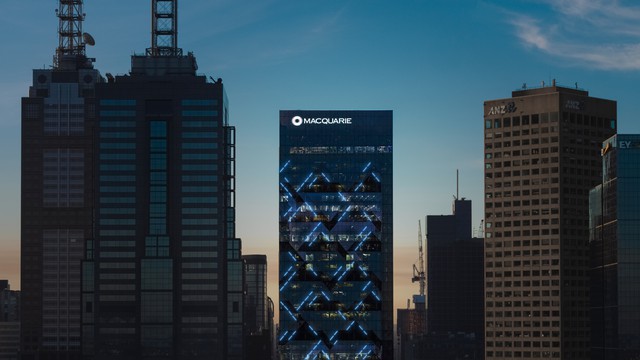Still Light 2020, Australia, Melbourne
Skyscraper appears to move with RAMUS’ installation, Still Light.


RAMUS’ new media architecture installation graces all 42-storeys of a new high-rise building. The structure of glass and steel seems to gently move, and even occasionally disappear, as the lights deliberately dematerialise its form on the Melbourne skyline.
RAMUS created Still Light, an installation gracing the façade of a new Collins St high-rise building. 42-storeys of light spans across a faceted glass façade, articulating the architectural features, creating the sense of a graceful, glinting movement. Over 1,136 metres of light and countless hours of visual content combine to create a gentle dance across the building façade. Still Light was inspired by naturally occurring moments of light seen in the gas lamps that historically lined Collins St. The light patterns in the façade reflect and refract like facets of a cut diamond. A project that was six years in the making, with client and the architects closely collaborating with RAMUS, the challenge was to create a set of highlights, without any fixtures being visible, and to create a sense of intimacy at the scale of a skyscraper. RAMUS developed a geometric layout that follows the facets, using three distinct sets of line-work; vertical, horizontal and diagonal. As we began to develop the content, we saw that the single element was much stronger than the combinations, and gave an abstract, non-linear interpretation of the building, as if the glints and reflections were being produced organically. We tested many different lighting methods, including fritting the glass, edge lighting an acrylic overlay, illuminating automated blinds and a sparkle strobe look that was externally mounted. We finally resolved on a simple colour-matched extrusion housing a linear Color Kinetics fixture that could be mounted internally, and installing those to bridge across the floor slabs, creating single lines of light that are up to 30m long. The artwork displays low-resolution animation with each individual light fixture, programmed by RAMUS’ creative team, forming a pixel on the 42-story ‘screen’. The colour palette is purposefully restricted, from warm white to almost amber, and cool white to almost blue. This parameter allows the movement to be the focus, not the colour, which in turn communicates the integrity of the piece, how the formless light integrates with the form of the building. As the light pattern moves, it shifts the buildings’ appearance in ways that balance the scale of the skyscraper with an intimacy that can be felt for kilometres.
Details
Building or project owner : QIC and Dexus
Architecture : Woods Bagot
Project artist/ concept/ design/ planning : RAMUS
Structural engineering : AECOM
Facade construction : Brookfield Multiplex
Descriptions
Facade type and geometry (structure) : Bruce Ramus, the Light Artist behind Still Light, wanted to challenge the common notion that lights must entertain or enthral. The result is lights that have purpose – the purpose of creating an intimate experience at scale. Architecture can often seem overpowering and intimidating and this work moves gently and deliberately to counteract the dominant structural nature of many urban designs. “Still Light brings a calming energy. It slows the pace and gently beckons people back into the CBD.” In line with Melbourne City Council street lighting guidelines, RAMUS was sensitive to creating an experience that felt gentle and impactful at human scale. Strobing and disruptive light patterns were excluded from the content sequence to ensure the façade did not cause disruption to residents in surrounding buildings.
Kind of light creation : Architectural Light Artwork
Resolution and transmitting behaviour : Still Light consists of 1,136m of individually mapped LED fixtures and RAMUS’ custom-built software platform called CORE. This bespoke control system operates each light fixture and integrates the content into a dynamic self-adjusting schedule that allows the building to respond to the different rhythms of the city. The work is mounted on the inner layer of the façade, with each light integrated into the frame of the glazing, creating a sense of the building itself being a light fixture. When that fixture turns on, the whole building starts to move, or so it seems.
Urban situation : As a building that operates 24 hours, RAMUS considered the change in rhythm that the Melbourne city has from day to day and morning to evening. These movements informed the timing of content, which is scheduled to be always-on. The outcome for the surrounding community is soothing, as each light movement reflects into the neighbouring laneways and onto architectural surfaces, creating a jewel-like effect across the footpaths and streets of the Paris end of Collins St.
Description of showreel : Introducing Still Light, RAMUS’ new media architecture installation that graces all 42-storeys of a new high-rise building.
Participatory architecture & urban interaction
Mediacredits
RAMUS
RAMUS
RAMUS